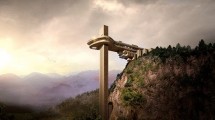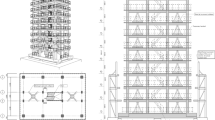Abstract
This study deals with the shaking table tests for two small-scale models (Model #1 and Model #2) of a concrete gravity dam, which has been planned for the construction with the recommendation of the peak ground acceleration of the maximum credible earthquake of 0.42 g. The development of bentonite-concrete mixture material, which matches the similitude requirements between the prototype and the model, is discussed. Two types of excitation, resonance test and ambient test, were conducted to investigate the resonant frequency, the maximum failure acceleration and the crack initiation/propagation. In both models, large amplification was observed at around 24–28 Hz. The crack initiated at the slope changing point and then propagated around the neck area. The crack failures were occurred at the base acceleration of 0.55 g–0.65 g.
Similar content being viewed by others
References
ABAQUS Inc. (2004). ABAQUS 6.5 Documentation.
Aidi, B. E. and Hall, J. F. (1989). “Non-linear earthquake response of concrete gravity dams: Modelling.” Earthq. Eng. Struct. Dyn., Vol. 18, pp. 837–851.
Bakhtin, B. M. and Dumenko, V. I. (1979). “Seismic stability of a concrete gravity dam having a lightweight profile.” Hydrotech. Construct., Vol. 5, pp. 445–450.
Bhattacharjee, S.S. and Leger, P. (1993). “Seismic cracking and energy dissipation in concrete gravity dam.” Earthq. Eng. Struct. Dyn., Vol. 22, No. 11, pp. 991–1007.
Bhattacharjee, S. S. and Leger, P. (1994). “Application of NLFM models to predict cracking in concrete gravity dams.” J. Struct. Eng., Vol. 120, No. 4, pp. 1255–1271.
Calayir, Y. and Karaton, M. (2005a). “A continuum damage concrete model for earthquake analysis of concrete gravity dam-reservoir systems.” Soil Dyn. Earthq. Eng., Vol. 25, pp. 857–869.
Calayir, Y. and Karaton, M. (2005b). “Seismic fracture analysis of concrete gravity dams including dam-reservoir interaction.” Comput. Struct., Vol. 83, pp. 1595–1606.
Cervera, M., Oliver, J., and Faria, R. (1995). “Seismic evaluation of concrete dams via continuum damage models.” Earthq. Eng. Struct. Dyn., Vol. 24v, pp. 1225–1245.
Donlon, W. P. (1989). Experimental investigation of the nonlinear seismic response of concrete gravity dams, Report No. 89-01, Earthquake Engineering Research Laboratory, California Institute of Technology Pasadena.
Donlon, W. P. and Hall, J. F. (1991). “Shake table study of concrete gravity dam monolith.” Earthq. Eng. Struct. Dyn., Vol. 20, pp. 769–786.
Ghaemian, M. and Ghobarah, A. (1999). “Nonlinear seismic response of concrete gravity dams with dam-reservoir interaction.” Eng. Struct., Vol. 21, pp. 306–315.
Ghaemmaghami, A. R. and Ghaemian, M. (2008). “Experimental seismic investigation of Sefid-Rud concrete buttress dam model on shaking table.” Earthq. Eng. Struct. Dyn., Vol. 37, pp. 809–823.
Ghobarah, A. and Ghaemian, M. (1998). “Experimental study of small scale dam models.” J. Eng. Mech., Vol. 124, No. 11, pp. 1241–1248.
Ghrib, F. and Tinawi, R. (1995). “An application of damage mechanics for seismic analysis of concrete gravity dams.” Earthq. Eng. Struct. Dyn., Vol. 24, pp. 157–173.
Hall, J. F. (1989). “The dynamic and earthquake behaviour of concrete dams.” Soil Dyn. Earthq. Eng., Vol. 7, pp. 58–121.
Harris, D. W., Snorteland, N., Dolen, T., and Travers, F. (2000). “Shaking table 2-D models of a concrete gravity dam.” Earthq. Eng. Struct. Dyn., Vol. 29, pp. 769–787.
Li, Q. S., Li, Z. N., Li, G. Q., Meng, J. F., and Tang, J. (2005). “Experimental and numerical seismic investigations of the Three Gorges dam.” Eng. Struct., Vol. 27, pp. 501–513.
Lin, G., Zhou, J., and Fan, C. (1993). “Dynamic model rupture test and safety evaluation of concrete gravity dams.” Dam Eng., Vol. 4, No. 3, pp. 769–786.
Loli, L. M. V. and Fenves, G. L. (1989). “Effect of concrete cracking on the earthquake response of gravity dams.” Earthq. Eng. Struct. Dyn., Vol. 18, pp. 575–592.
Mao, M. and Taylor, C. A. (1997). “Non-linear seismic cracking analysis of medium-height concrete gravity dams.” Comput. Struct., Vol. 64, pp. 1197–1204.
Mir, R. A. and Taylor, C. A. (1995). “An experimental investigation into earthquake-induced failure of medium to low height concrete gravity dam.” Earthq. Eng. Struct. Dyn., Vol. 24, pp. 373–393.
Mir, R. A. and Taylor, C. A. (1996). “An investigation into the base sliding response of rigid concrete gravity dams to dynamic loading.” Earthq. Eng. Struct. Dyn., Vol. 25, pp. 79–98.
Mirzabozorg, H. and Ghaemian, M. (2005). “Non-linear behavior of mass concrete in three-dimensional problems using a smeared crack approach.” Earthq. Eng. Struct. Dyn., Vol. 34, pp. 247–269.
Niwa, A. and Clough, R. W. (1980). Shaking table research on concrete dam models, Report No. UCB/EERC-80-05, Earthquake Engineering Research Center, College of Engineering, University of California Berkeley, California.
Tinawi, R., Leger, P., Leclerc, M., and Cipolla, G. (2000). “Seismic safety of gravity dams: from shake table experiments to numerical analyses.” J. Struct. Eng., Vol. 126, No. 4, pp. 518–529.
Wieland, M. (2003). “Seismic aspects of dams.” Proceedings of the 21st International Congress on Large Dams, ICOLD, Montreal Canada.
Wieland, M., Brenner, P., and Sommer, P. (2003). “Earthquake resiliency of large concrete dams: Damage, repair, and strengthening concepts.” Q.83, Proceedings of the 21st International Congress on Large Dams, ICOLD, Montreal Canada.
Zadnik, B. (1994). “Motions of rigid unsymmetric bodies and coefficient of friction by earthquake excitations.” Struct. Eng. Mech., Vol. 2, No. 33, pp. 257–267.
Zadnik, B. and Paskalov, T. (1992). “Dam stability and time-dependent coefficient of friction.” Proceedings of the 10th World Conference on Earthquake Engineering, Balkema, Rotterdam, The Netherlands, pp. 4633–4638.
Author information
Authors and Affiliations
Corresponding author
Rights and permissions
About this article
Cite this article
Phansri, B., Charoenwongmit, S., Yooprasertchai, E. et al. An experimental study on shaking table tests on models of a concrete gravity dam. KSCE J Civ Eng 19, 142–150 (2015). https://doi.org/10.1007/s12205-014-1221-8
Received:
Revised:
Accepted:
Published:
Issue Date:
DOI: https://doi.org/10.1007/s12205-014-1221-8




